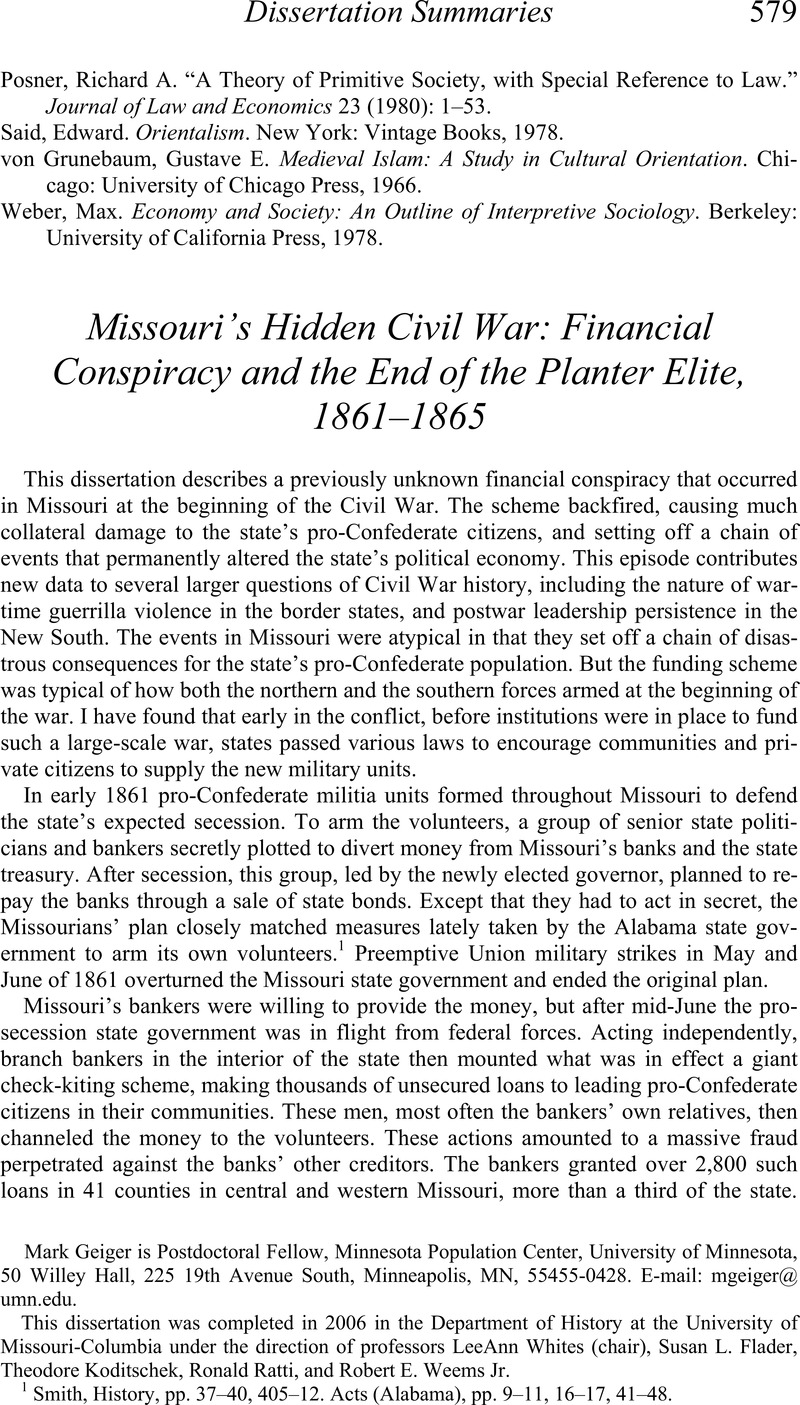No CrossRef data available.
Article contents
Missouri's Hidden Civil War: Financial Conspiracy and the End of the Planter Elite, 1861–1865
Published online by Cambridge University Press: 01 June 2008
Abstract
An abstract is not available for this content so a preview has been provided. Please use the Get access link above for information on how to access this content.

- Type
- Other
- Information
- Copyright
- Copyright © The Economic History Association 2008
References
REFERENCES
Acts of the Called Session of the General Assembly of Alabama, Held in the City of Montgomery, Commencing on the Second Monday in January, 1861. Montgomery, AL: Shorter & Reid, State Printers, 1861.Google Scholar
Acts and Resolutions Passed at the Extra Session of the Eighth General Assembly of the State of Iowa, Which Convened at the Capitol in Des Moines on Wednesday, the 15th Day of May, 1861. Des Moines, IA: F. W. Palmer, State Printer, 1861.Google Scholar
Acts of the General Assembly of the State of Georgia, Passed in Milledgeville, at an Annual Session in November and December, 1861. Milledgeville, GA: Boughton, Nisbet & Barnes, State Printers, 1861.Google Scholar
Acts of the General Assembly of the State of South Carolina, Passed in November and December, 1860, and January, 1861. Columbia, SC: Charles P. Pelham, State Printer, 1861.Google Scholar
Appleby, Joyce. Capitalism and a New Social Order: the Republican Vision of the 1790s. New York: New York University Press, 1984.Google Scholar
Bankers Magazine and Statistical Register.Google Scholar
Cable, John R. “The Bank of the State of Missouri.” In Studies in History, Economics and Public Law, vol. 102, no. 2. New York: Columbia University Press, 1923.Google Scholar
Clark, Christopher. “The Consequences of the Market Revolution in the American North.” In The Market Revolution in America: Social, Political, and Religious Expressions, 1800–1880, edited by Stokes, Melvyn and Conway, Stephen. Charlottesville: University Press of Virginia, 1996.Google Scholar
Geiger, Mark W.“Missouris Hidden Civil War: Financial Conspiracy and the Decline of the Planter Elite, 1861–1865.” Ph.D. diss., University of Missouri, 2006. http://edt.missouri.edu/Winter2006/Dissertation/GeigerM-050406-D4430/.Google Scholar
Huston, James A.The Sinews of War: Army Logistics 1775–1953. Washington, D. C.: Office of the Chief of Military History, United States Army, 1966.Google Scholar
Lamoreaux, Naomi R.Insider Lending: Banks, Personal Connections, and Economic Development in Industrial New England. New York: Cambridge University Press, 1994.CrossRefGoogle Scholar
Marler, Scott. “Rural Merchants and Consumers in a New South Louisiana, 1840–1940.” Ph.D. diss., Rice University, 2006.Google Scholar
Public Laws of the State of Illinois, Passed by the Twenty-Second General Assembly, Convened January 7, 1861. Springfield, IL: Bailhache and Baker, Printers, 1861.Google Scholar
Skowronek, Steven. Building a New American State: The Expansion of National Administrative Capacities, 1877–1920. New York: Cambridge University Press, 1982.CrossRefGoogle Scholar
Smith, William R.The History and Debates of the Convention of the People of Alabama: Begun and Held in the City of Montgomery, on the Seventh day of January, 1861: In which is Preserved the Speeches of the Secret Sessions, and Many Valuable State Papers. Montgomery, AL: White, Pfister & Co., 1861.Google Scholar
Stamp, Kenneth. And the War Came: The North and the Secession Crisis, 1860–1861. Baton Rouge: Louisiana State University Press, 1950.Google Scholar
Watson, Harry L. “Slavery and Development in a Dual Economy: The South and the Market Revolution.” In The Market Revolution in America: Social, Political, and Religious Expressions, 1800–1880, edited by Stokes, Melvyn and Conway, Stephen. Charlottesville: University Press of Virginia, 1996.Google Scholar
Wilson, Mark R.The Business of Civil War: Military Mobilization and the State, 1861–1865. Baltimore: Johns Hopkins University Press, 2006.CrossRefGoogle Scholar


